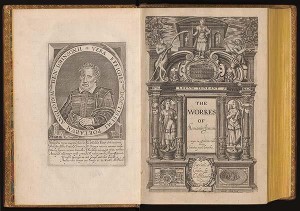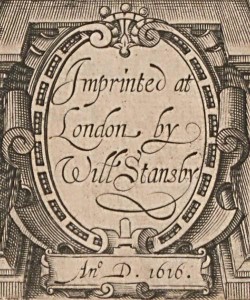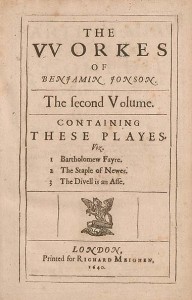A Tale of Two Ben Jonson Folios
In 2014, the Baillieu Library made a very special acquisition: a copy of the Second Folio of The workes of Ben Jonson (2 volumes, 1631-40). The University of Melbourne is fortunate to have Ian Donaldson as one of its Honorary Professorial Fellows: Prof. Donaldson is the author of a critically acclaimed biography of Jonson (Ben Jonson: a life. Oxford: OUP, 2011) and is one of the General Editors of the Cambridge edition of the works of Ben Jonson (Cambridge: CUP, 2012). The acquisition of this collection of Jonson plays and writings was thus a good fit for the University’s collections, and complemented other Rare Books holdings including the Second Folio of Shakespeare’s works (1632) and the First Folio of Beaumont and Fletcher’s works (1647). The Jonson volumes also feature the bookplates of Alfred Henry Littleton and Estelle Doheny, the latter already represented in Baillieu holdings through her copy of Eusebius.
But the printing of the Jonson Second Folio is an extremely complex case. It typically exists in two volumes. The first is a second edition of Jonson’s 1616 First Folio. The second comprises additional material that had been assembled from as early as 1631, but was not published in this form until 1640 (three years after Jonson had died). Moreover, this second volume consists of four ‘parts’, which are bound in different orders in different copies. (The Baillieu’s is in the order: part I, part iv, part iii, part ii).
One of the distinctive features of the Second Folio is the presence of an engraved portrait of Jonson by Robert Vaughan, who flourished throughout the 1620s. On the face of it then, the Baillieu’s volume 1 looks like a copy from the Second Folio:

The first volume of F2 was meant to be a second edition of F1, including the reproduction of William Hole’s elaborately engraved titlepage featuring the allegorical figures of “TRAGŒDIA”, “COMŒDIA”, “TRAGICOMŒDIA”, “SATYR” AND “PASTOR”. The only difference was the imprint, which was burnished and now read “LONDON. | Printed by | Richard Biſhop, | and are to be ſold by | Andrew Crooke, | in S t, Paules, | Church-yard. | Ano D. 1640”, where it had earlier been marked with the name of another stationer, William Stansby, and the 1616 date.
Although the Baillieu copy clearly includes the Vaughan portrait usually found in F2, the imprint of the titlepage bears the 1616 date and Stansby’s name, not the 1640 date and the names of Bishop and Crooke, which ought to be present if this were a genuine F2. So clearly, one of these two pages does not belong. Is it a Second Folio augmented by the introduction of an excised titlepage from F1? Or is it a First Folio augmented by the addition of the Vaughan portrait created in the 1620s?

The bibliographical definition of a new “edition” turns on the fact that, rather than a printer simply re-inking an existing galley of type which had been previously set (for the first printing), more work is involved: the pieces of type need to be reset from scratch (well, at least half of them, if we want to be technical) [1]. Resetting by hand in this manner typically means changes will be introduced, either inadvertently or deliberately. In the case of the Jonson F2, the printer was keen to economise, as David Gants explains in his textual essay for the Cambridge edition: “In designing the second edition of F1, Bishop retained the same general layout as the first, although the number of lines per page increased from 47 to 50, which, along with other minor revisions, reduced the total number of sheets from 257 to 227”.
Sure enough, a quick line count of various pages of the Baillieu volume shows that it is more generously spaced, in line with the features of a First Folio. Differences in the prefatory material clinches it: a comparison with a genuine Second Folio via Early English books online shows a number of differences in the dedicatory poems but an exact correspondence to the prefatory material of a First Folio.

So someone – perhaps because they already owned this First Folio – did not see any point in purchasing the second edition (volume 1 of F2) but did bother to source the Vaughan portrait, and had it added to their F1. They did then proceed to acquire volume 2 of F2, which contains the additional material not printed in 1616. This included such plays as Bartholomew Fair, The Staple of News, and The Devil is an Ass, as well as various masques and the fragment of a play called “Mortimer, His Fall” which the author left unfinished at his death. These two volumes were then beautifully bound by Francis Bedford in the nineteenth century.
Guest blogger: Dr David McInnis, Gerry Higgins Lecturer in Shakespeare Studies (mcinnisd@unimelb.edu.au) and curator of the forthcoming After Shakespeare exhibition, Noel Shaw Gallery, Baillieu Library, 14 July 2016-11 February 2017.
Explore this link for further information about the After Shakespeare exhibition.
[1] Philip Gaskell. A new introduction to bibliography. Oxford : OUP, 1979, p. 313.
Categories
- Uncategorised
- Rare Books
- Special Collections
Leave a Reply